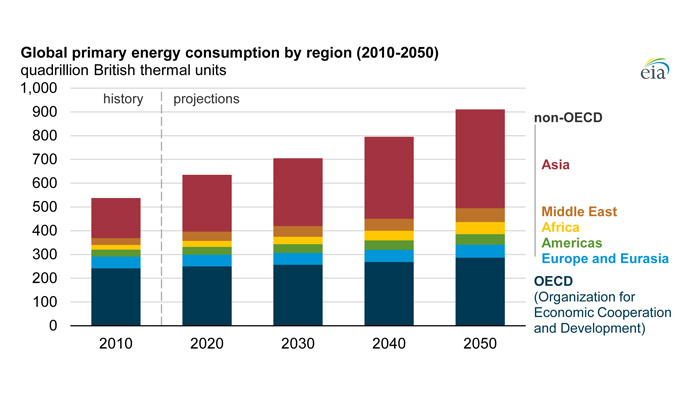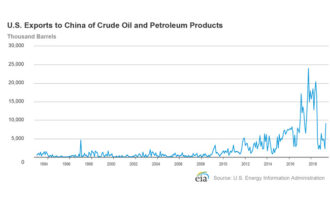
EIA projects nearly 50% increase in world energy usage by 2050, led by growth in Asia
The U.S. Energy Information Administration (EIA) projects that world energy consumption will grow by nearly 50% between 2018 and 2050 in its newly released International Energy Outlook 2019. Most of this growth comes from countries that are not in the Organization for Economic Cooperation and Development (OECD), and this growth is focused in regions where strong economic growth is driving demand, particularly in Asia.
EIA’s 2019 outlook assesses long-term world energy markets for 16 regions of the world, divided according to OECD and non-OECD membership. Projections for the United States are consistent with those released in the Annual Energy Outlook 2019.
The industrial sector, which includes refining, mining, manufacturing, agriculture, and construction, accounts for the largest share of energy consumption of any end-use sector — more than half of end-use energy consumption throughout the projection period. World industrial sector energy use increases by more than 30% between 2018 and 2050 as consumption of goods increases. By 2050, global industrial energy consumption reaches about 315 quadrillion British thermal units (Btu).
Transportation energy consumption increases by nearly 40% between 2018 and 2050. This increase is largely driven by non-OECD countries, where transportation energy consumption increases by nearly 80% between 2018 and 2050. Energy consumption for both personal travel and freight movement grows in these countries much more rapidly than in many OECD countries.
Energy consumed in the buildings sector, which includes residential and commercial structures, increases by 65% between 2018 and 2050, from 91 quadrillion to 139 quadrillion Btu. Rising income, urbanization, and increased access to electricity lead to rising demand for energy.
The growth in end-use consumption results in electricity generation increasing by 79% between 2018 and 2050. Electricity use grows in the residential sector as rising population and standards of living in non-OECD countries increase the demand for appliances and personal equipment. Electricity use also increases in the transportation sector as plug-in electric vehicles enter the fleet and electricity use for rail expands.
With the rapid growth of electricity generation, renewables — including solar, wind, and hydroelectric power — are the fastest-growing energy source between 2018 and 2050, surpassing petroleum and other liquids to become the most used energy source in the reference case. Worldwide renewable energy consumption increases by 3.1% per year between 2018 and 2050, compared with 0.6% annual growth in petroleum and other liquids, 0.4% growth in coal, and 1.1% annual growth in natural gas consumption.
Global natural gas consumption increases more than 40% between 2018 and 2050, and total consumption reaches nearly 200 quadrillion Btu by 2050. In addition to the natural gas used in electricity generation, natural gas consumption increases in the industrial sector. Chemical and primary metals manufacturing, as well as oil and natural gas extraction, account for most of the growing industrial demand.
Global liquid fuels consumption increases more than 20% between 2018 and 2050, and total consumption reaches more than 240 quadrillion Btu in 2050. Demand in OECD countries remains relatively stable during the projection period, but non-OECD demand increases by about 45%.
echo '








